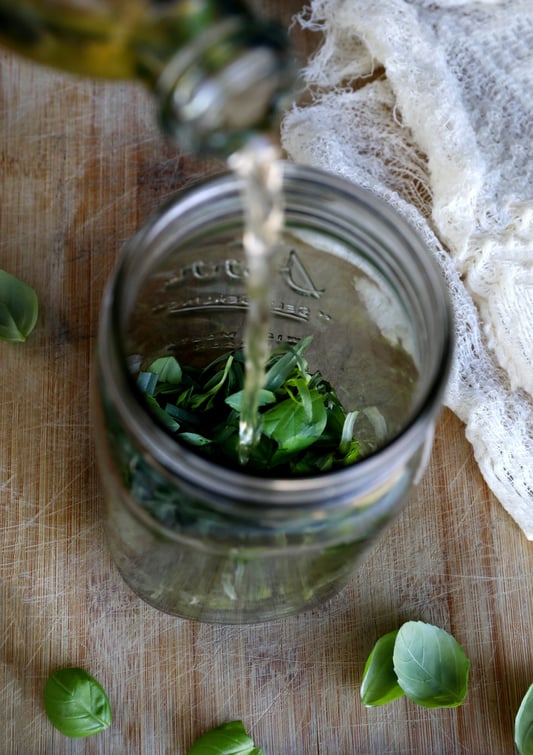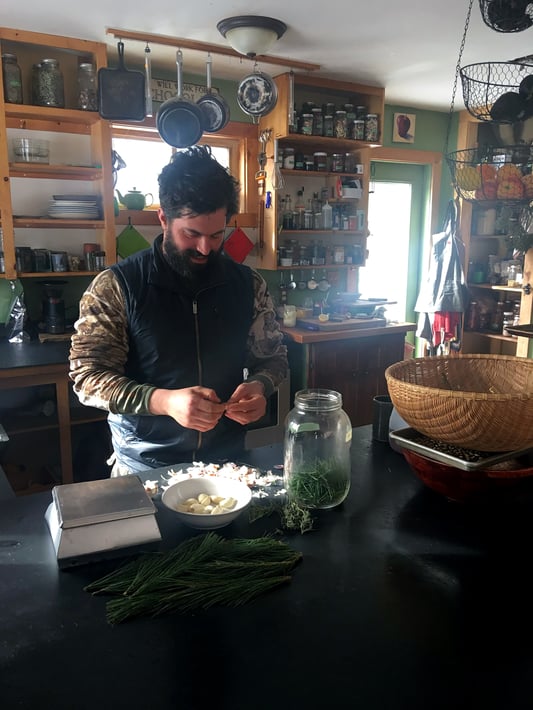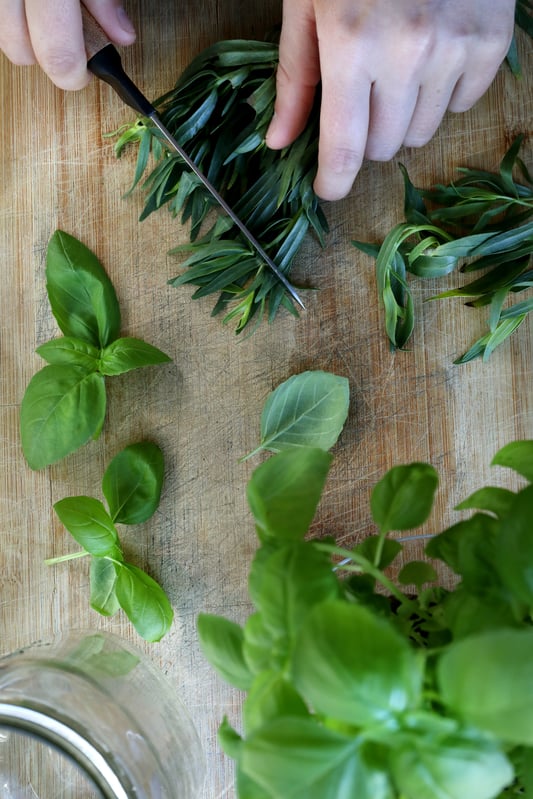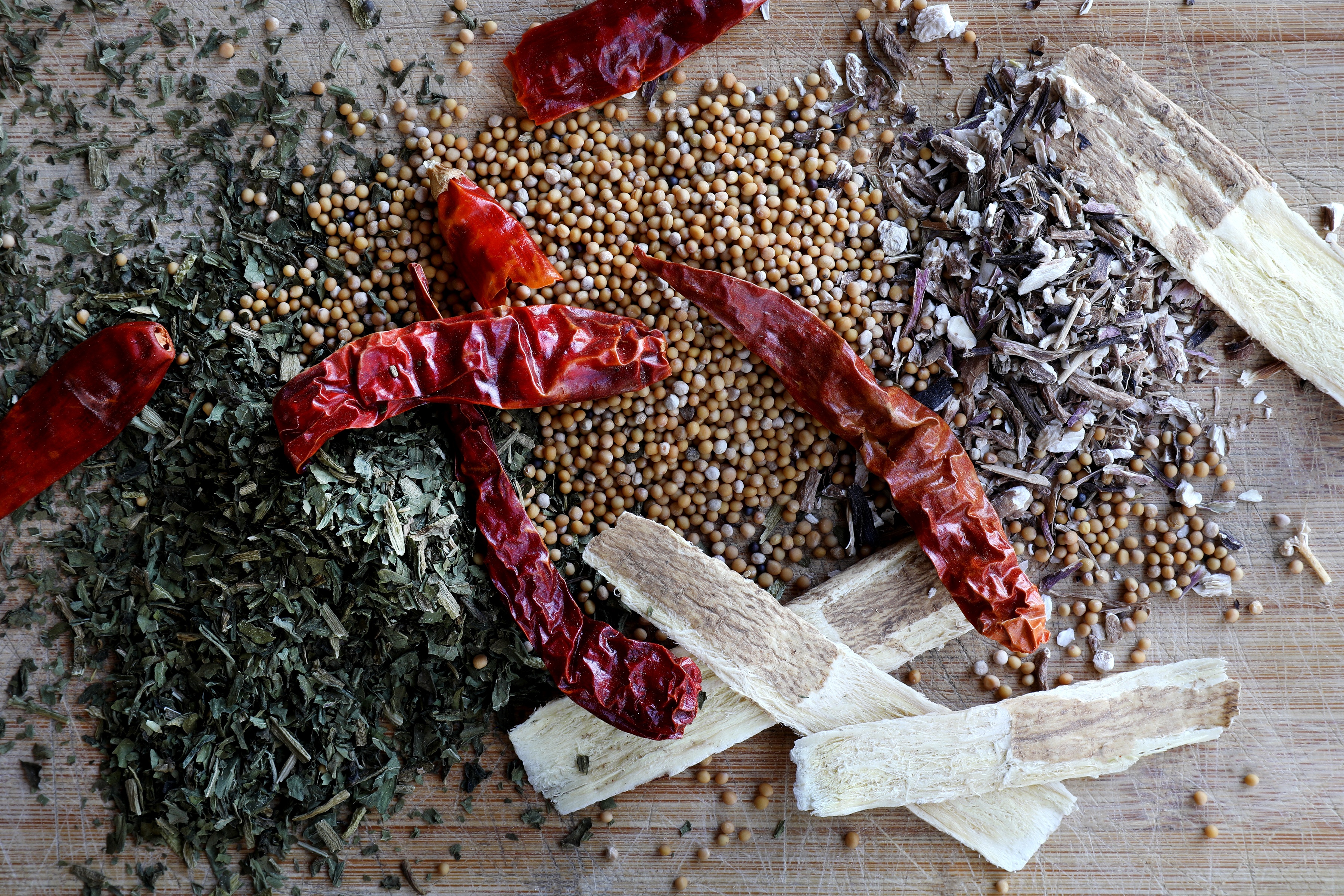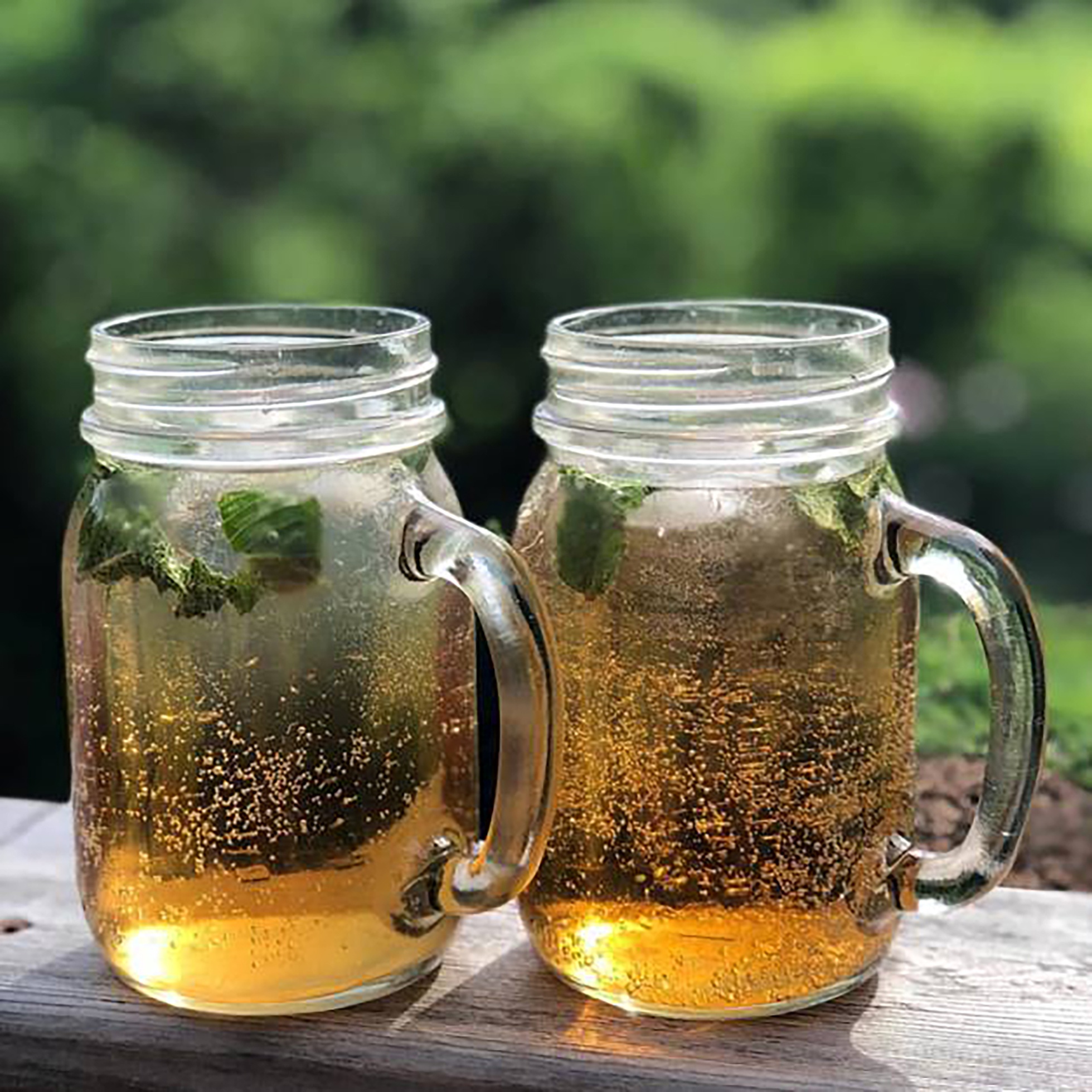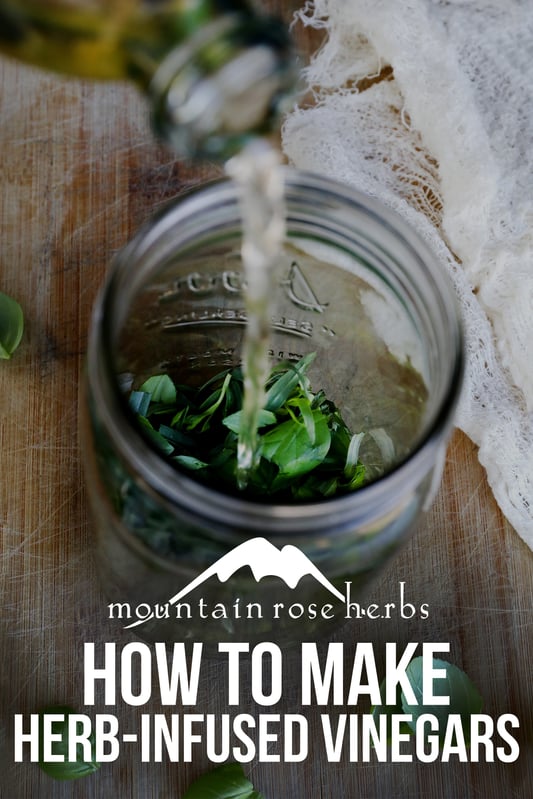Food preservation has been around for thousands of years. From drying acorns for extended storage to turning grapes into wine, the act of preservation has allowed people around the globe to enjoy various foods and botanicals well past their harvest season. As a chef and homesteader, I often find myself having way more fresh ingredients than I can use before they turn. This is where food preservation comes into play! I do my best to appropriately utilize as much as I can so that my family may enjoy the spring, summer, and autumn harvest well into the cold winters of Maine. Extra cabbage gets salt and turns to sauerkraut, excess peaches get pureed and dehydrated into fruit leather, and the list goes on. Over the years, I have become particularly fond of vinegar and its acidic properties to capture the essence, flavor, and minerals naturally found in fruits and herbs.
Why I Make Vinegar Extracts
Much like using alcohol to make tinctures, vinegar is a culinary go-to for preserving and enhancing a variety of ingredients. Although alcohol does a fantastic job of extracting flavor and constituents, I find it often doesn't quite fit into my culinary repertoire. Vinegar extracts, however, seamlessly work their way into my daily creations.
Beyond the flavor, what I love most about making vinegar extracts is how easy they are to create. A little hands-off effort and patience yields delicious results that you can enjoy for months to come.
A Good Vinegar Extract Starts with Good Vinegar
Any vinegar can be used to make an extract, but take note that not all vinegars are created equal, and this should be taken into consideration when using them in an extract. The natural flavor found in the vinegar you choose will impact the taste of your finished product. Much like combining herbs and spices to season a dish, some thought should go into how your vinegar choice will work with the other ingredients in your extract. You may find that balsamic vinegar combines nicely with herbs like tarragon, rosemary, or basil, and rice wine vinegar extracts a beautiful color from plums. Apple cider vinegar tends to be a good "all around-er", imparting a complementary flavor to a variety of ingredients.
For this application, you will want to use a vinegar that has a 5% acidity. Some vinegar will naturally be at this level, while others may be diluted with water to reach this acidity. Either can be used here.
I prefer working with organic vinegars that are traditionally prepared. Be sure to read the label before purchasing. For example, although distilled white vinegar is quite neutral in flavor and nicely picks up the color of the ingredients you are working with, most are made from corn, which may or may not be from bioengineered sources.
Personally, I find unpasteurized apple cider vinegar with “the mother” to be the best vinegar for making an extract. Unlike refined vinegars, this kind of vinegar still retains its culture of beneficial bacteria, similar to a SCOBY in kombucha making. As a lifelong New Englander, I am quite fond of this ingredient and am able to source the vinegar I use from local and organic vinegar producers.
A few vinegar options to consider when making an herbal vinegar extract:
- Unpasteurized apple cider vinegar (with "the mother")
- Balsamic vinegar
- Red wine vinegar
- Sherry vinegar
- Rice wine vinegar
- Distilled white vinegar
- White wine vinegar
- Champagne vinegar
- Ume plum vinegar
What to Extract with Vinegar
Just like an array of vinegars can be used to make your extract, a variety of ingredients can be extracted. That being said, I tend to stick with herbs and fruits to make my extracts. With plenty of vinegar on hand at all times, I allow the season’s bounty to dictate what I preserve. In years past, I have made extracts using strawberries, sage, garlic, elder berries, blueberries, mulberries, rosemary, thyme, peaches, nettle, horsetail, and the list goes on.
Either fresh or dried ingredients may be used, with only a few considerations to keep in mind. If using fresh herbs, make sure they are washed free of dirt and patted dry. Don't skip the patting dry step, as water can dilute your vinegar and cause bacterial growth inside your extract. Fruit can be used fresh or dried, but avoid using frozen or previously frozen varieties because they will have a higher water content from the formation of ice crystals.
Some Botanicals for Vinegar Extracts
- Astragalus root
- Chili peppers
- Chives, scallions, or shallots
- Horseradish
- Motherwort
- Lemon verbena
- Mustard seeds
- Lavender
- Dill weed
- Dandelion leaves, flowers, or root
- Yarrow
Gather Your Extraction Tools
As with other culinary projects, you will want to make sure you have everything you need on hand to make this preparation smooth and simple. Because of the acidic nature of vinegar, it’s best to use glass for your extractions. Avoid plastic, as it can leach into your vinegar. You can sterilize your jars by submerging and boiling them in water for 10 minutes. I prefer wide mouth jars to make removing your material easier in the end. Additionally, you’ll need cheesecloth, a fine mesh strainer, parchment paper, rubber bands, sharpie markers, and labels to make a safe and delicious end product.
Vinegar Extraction Methods: Heated vs. Unheated
There are two methods one can use for making vinegar extracts. Which one you choose will depend on your priorities and chosen plant material. You can either heat the vinegar and pour it over your material, or simply combine unheated vinegar and herbs to make your extract. I personally stick to the latter option, mostly to preserve the healthful properties of the unpasteurized apple cider vinegar. If using dried herbs or fruit (botanicals with thicker/tougher coverings), you may get a better extraction by heating your vinegar first.
Each ingredient you wish to extract is going to act differently in the vinegar, and as you become more familiar with the outcomes, you will better understand just how much of each ingredient to work with. When creating your vinegar with fresh ingredients, I find a ratio of 2:1 (vinegar to herbs/fruit) works best and creates a really flavorful product. If using dried material, just a few tablespoons per pint jar will do the trick.
Occasionally, you will find a kombucha-like SCOBY forming on the top of your vinegar, either during the extraction process or later on after your vinegar has been strained. Although not harmful, this formation does indicate that the vinegar is entering another stage of fermentation which can ultimately dilute your product. In order to keep your vinegar at its most flavorful, simply remove the forming SCOBY from the bottle with tongs, tweezers, or (clean!) hands, or strain the liquid through a fine mesh strainer.
How to Make an Unheated Vinegar Extract
Yield depends on container size used to infuse, scale to your needs.
Ingredients
For fresh herbs
- 2 parts organic vinegar of your choice
- 1 part fresh organic fruit, herb, root, bark, or a blend of these
For dried herbs
- 1 part dried organic herb
- 15 parts vinegar
- For example, add 2 Tbsp. dried herb to a pint jar, fill remainder with vinegar
Directions
- Place appropriate amount of plant material in jar (see above for fresh and dried proportions). You can gently mash fresh fruit, or roughly chop denser plant material for a more thorough extraction.
- Pour in enough vinegar to fill jar to about 1/2 inch from the top.
- Wipe any liquid off rim, then cover opening with parchment and secure with
rubber band. - Label and date your jar.
- Store your jar in a cool, dark place and let extract for two to four weeks. Some denser ingredients may go beyond a month for a more complete extraction. I tend to remove the parchment paper, cover with a lid, and shake the jar every few days to assist in the extraction.
- When the allotted time is up, strain your vinegar through a fine mesh strainer. Push
down on the material to release as much of the vinegar as possible. Pour your finished product into small bottles, label, and date. - Enjoy your vinegar extracts in all of your culinary creations!
How to Make a Heated Vinegar Extract
Ingredients
- See "How to Make an Unheated Vinegar Extract" ingredients above.
Directions
- Heat your vinegar to 180°F.
- Follow the steps for making an unheated herbal extract (above).
How to Use Your Vinegar Extracts
Herbal vinegars are fun and easy to use. They can be substituted in place of any unflavored vinegar, and you will find they enhance virtually any culinary creation. Enjoy herbal vinegars as the base of any salad dressing or vinaigrette. Marinades, sauces, or simple splashes in soups are all fantastic ways to use your herb-infused vinegars.
For the herbalists in all of you, vinegar extracts can also be turned into several beneficial products. A touch of honey added to your extracts creates yummy oxymels, which I take sublingually or add to beverages throughout the year. I will also use my flavored vinegars as the base for shrubs, also known as "drinking vinegars," of which I am particularly fond.
Interested in other herbal preservation methods?
Learn to Make Alcohol-Free Glycerin Extracts!
You may also be interested in:
- Herbal Honey and Vinegars: How to Make an Oxymel
- How to Make Fire Cider
- Tom Kha Inspired Fire Cider Recipe

